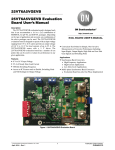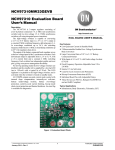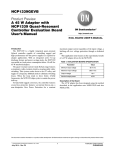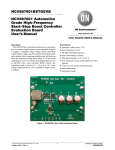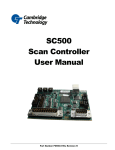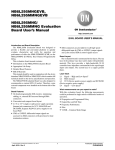Download EVBUM2227 - 25VT6A5VGEVB Evaluation Board User`s Manual
Transcript
Test Procedure for the 25VT6A5VGEVB Evaluation Board Test Setup The test set up, test points and components present on the 25VT6A5VGEVB Evaluation Board are shown in Figure 4. The MOSFET parts placed on the evaluation board are the Q1 and Q4 (Refer to Figure 1). Figure 4. Schematic of the Test Setup Start up and Shut down Procedures Before starting the test, the oscilloscope probes should be connected. IR or k−type thermo−couples can be used to monitor the temperature of the parts. IR monitoring requires the removal of the oscilloscope probes due to the IR beam interference. Start up Procedure (VOUT 0.8 V – 1.56 V): 1. Initially set all the power supplies to 0 V. 2. Set the output voltage to the desired value by changing the VID settings on SW2 (see Appendix). The SW2 must be changed while the driver and controller are off. 3. Set the driver voltage and controller voltage to 5 V. 4. Set the inptut voltage to the desired value (8 V – 16 V). 5. VOUT Adjustments: the output voltage may be fine-tuned at this time, by adjusting the R60 potentiometer. 6. Set the load current to the required value. The load current must be incremented slowly to prevent the controller from shutting down due to transient spikes on the inductor current sense lines (CS1, CS2 in Figure 2). If the controller shuts down, there are two different methods that can be used to reset the controller. The first 4/30/2014 1 method is to toggle Pin 8 (EN) of the Grayhill switch (SW2) to 0 (down position) and then back to 1 (up position). The second method is to set VIN to 0 V and then back up to the desired voltage, then turned on and Vin re−established. Start up Procedure (VOUT 1.56 V – 1.8 V): 1. Initially set all the power supplies to 0 V. 2. Set the output voltage to 1.56 V by changing the VID settings on SW2 (see Appendix). The SW2 must be changed while the driver and controller are off. 3. Set the driver voltage and controller voltage to 5 V. 4. Set the input voltage to the desired value (8 V – 16 V). 5. Adjust the output voltage using the R60 potentiometer until the desired output voltage is reached (1.8 V maximum). 6. Set the load current to the required value. The load current must be incremented slowly to prevent the controller from shutting down due to transient spikes on the inductor current sense lines (CS1, CS2 in Figure 2). If the controller shuts down, there are two www.onsemi.com different methods that can be used to reset the controller. The first method is to toggle Pin 8 (EN) of the Grayhill switch (SW2) to 0 (down position) and then back to 1 (up position). The second method is to set VIN to 0 V and then back up to the desired voltage, then turned on and Vin re−established. 3. 4. Reduce the input voltage to zero and then shut down the input power supply. Reduce the driver voltage and controller voltage to zero. Then shut down the driver power supply and controller power supply. Test Procedure 1. Shut down Procedure (VOUT 0.8 V – 1.56 V): 1. Shut down the load. 2. Reduce the input voltage to zero and then shut down the input power supply. 3. Reduce the driver voltage and controller voltage to zero. Then shut down the driver power supply and controller power supply. Shut down Procedure (VOUT 1.56 V – 1.8 V): 1. Shut down the load. 2. Adjust the potentiometer until the output voltage measures 1.56 V. 4/30/2014 2. 3. 4. 5. 6. 2 Before making any connections, make sure to set all power supplies to 0 V, and make sure the load current is 0 A. Connect the oscilloscope probes at the desired test points. Connect the voltmeters / multi-meters to monitor the required parameters (refer to Figure 4). Set the output voltage to 1.2 V and the input voltage to 12 V, following the Start-Up Procedure specified in the previous section. Obtain the required data and waveforms Follow the Shut-Down Procedure specified in the previous section. www.onsemi.com TEST RESULTS The following test results were obtained for the 25VT6A5VGEVB evaluation board by following the Test Procedure listed above. The selected MOSFETs were evaluated in a 1 x 1 combination. Figure 5. Efficiency of NTTFS4H07N x NTMFS4H02NF for VIN = 12 V, VOUT = 1.2 V, VDRV = 5 V, FSW = 500 kHz Figure 6. Switch Node and Gate Waveforms of NTTFS4H07N x NTMFS4H02NF taken at IOUT = 20 A 4/30/2014 3 www.onsemi.com



